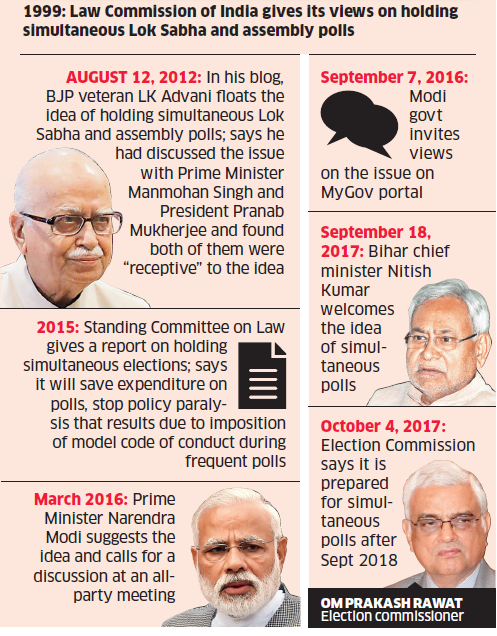Contact Us
info.littleofficers@gmail.com
Phone
+91 7042039300
+91 7042049700

Context: A High-Level Committee (HLC) headed by Ramnath Kovind, former President of India, was constituted in September 2023 to examine the issue of holding simultaneous elections for the Lok Sabha, State Legislative Assemblies and local bodies of all States. The HLC has invited responses from political parties, the Law Commission and other groups on the proposal to hold simultaneous elections.
Introduction: Simultaneous elections in India refer to the concept of holding elections for both the Lok Sabha (the lower house of India's Parliament) and the state legislative assemblies at the same time, rather than at different intervals as is the current practice.
History of Simultaneous Elections
In India, simultaneous elections to the Lok Sabha (House of The People) and Vidhan Sabhas (State Legislative Assemblies) were held in the years 1951-52, 1957, 1962 and 1967. Thereafter, however, the schedule could not be maintained and the elections to the Lok Sabha and the Vidhan Sabhas have still not been realigned.
Justification For Holding Simultaneous Elections
It was felt that holding simultaneous elections would reduce the massive expenditure incurred for conduct of separate elections every year. Presently, the cost of holding elections for Lok Sabha and Legislative Assemblies of States and UTs has been pegged at Rs. 4500 crore by the ECI.
Elections lead to imposition of Model Code of Conduct (MCC) in the poll bound State/area and as a result, the entire development programme and activities of the Union and State Governments in the poll bound State would come to a standstill.
Frequent elections lead to disruption of normal public life and impact the functioning of essential services.
It would free the crucial manpower which is often deployed for prolonged periods on election duties.
Challenges in holding Simultaneous Elections
Despite its desirability, there are several difficulties which might be encountered for conducting simultaneous elections. The process of simultaneous elections pose significant logistical, constitutional, and practical challenges. India's diverse political landscape, federal structure, and constitutional provisions would require extensive amendments to facilitate such a change. Additionally, concerns have been raised about its impact on federalism, political accountability, and the ability of smaller parties and independent candidates to compete effectively.
Recommendations by various commissions and Committees
The reports of the Law Commission (1999), and the Parliamentary Standing Committee on Personnel, Public Grievances, Law and Justice (2015), have dealt with the issue of simultaneous elections. The Law Commission had also submitted a draft report in 2018. The highlights of these discussions and recommendations can be summarised as follows:
The elections to the Lok Sabha and nearly half of the State assemblies may be clubbed together in one cycle, while the rest of the State assembly elections can be held in another cycle after two and half years. This will require curtailing or extending the tenures of existing assemblies that will entail amendments to the Constitution and the Representation of the People Act, 1951
If for any unavoidable reason, the Lok Sabha or State Assembly is to be dissolved prematurely, the duration of the newly constituted House should be only for the remainder period of the original House. This would act as a deterrent for MPs and MLAs pushing for premature dissolution of the House. It would instead encourage the members to explore the possibility of forming an alternate government through feasible realignments
The bye-elections necessitated by death, resignation or disqualification of members can be clubbed together and conducted once in a year.

What can be an ideal solution?
There is a lack of consensus among various political parties about the conduct of simultaneous elections. It's a complex issue that requires careful consideration of various factors before any decision can be made.